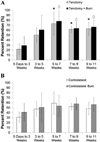Early detection of heterotopic ossification using near-infrared optical imaging reveals dynamic turnover and progression of mineralization following Achilles tenotomy and burn injury
- PMID: 25087685
- PMCID: PMC4408934
- DOI: 10.1002/jor.22697
Early detection of heterotopic ossification using near-infrared optical imaging reveals dynamic turnover and progression of mineralization following Achilles tenotomy and burn injury
Abstract
Heterotopic ossification (HO) is the abnormal formation of bone in soft tissue. Current diagnostics have low sensitivity or specificity to incremental progression of mineralization, especially at early time points. Without accurate and reliable early diagnosis and intervention, HO progression often results in incapacitating conditions of limited range of motion, nerve entrapment, and pain. We hypothesized that non-invasive near-infrared (NIR) optical imaging can detect HO at early time points and monitor heterotopic bone turnover longitudinally. C57BL6 mice received an Achilles tenotomy on their left hind limb in combination with a dorsal burn or sham procedure. A calcium-chelating tetracycline derivative (IRDye 680RD BoneTag) was injected bi-weekly and imaged via NIR to measure accumulative fluorescence for 11 wk and compared to in vivo microCT images. Percent retention of fluorescence was calculated longitudinally to assess temporal bone resorption. NIR detected HO as early as five days and revealed a temporal response in HO formation and turnover. MicroCT could not detect HO until 5 wk. Confocal microscopy confirmed fluorophore localization to areas of HO. These findings demonstrate the ability of a near-infrared optical imaging strategy to accurately and reliably detect and monitor HO in a murine model.
Keywords: biomarkers; heterotopic Ossification; microCT; molecular imaging.
© 2014 Orthopaedic Research Society. Published by Wiley Periodicals, Inc.
Figures






References
-
- Vanden Bossche L, Vanderstraeten G. Heterotopic ossification: a review. J Rehabil Med. 2005;37:129–136. - PubMed
-
- Burd TA, Lowry KJ, Anglen JO. Indomethacin compared with localized irradiation for the prevention of heterotopic ossification following surgical treatment of acetabular fractures. J Bone Joint Surg Am. 2001;83:1783–1788. - PubMed
-
- Cullen N, Perera J. Heterotopic Ossification: pharmacologic options. J Head Trauma Rehabil. 2009;24:69–71. - PubMed
Publication types
MeSH terms
Substances
Grants and funding
LinkOut - more resources
Full Text Sources
Other Literature Sources
Medical
Miscellaneous

